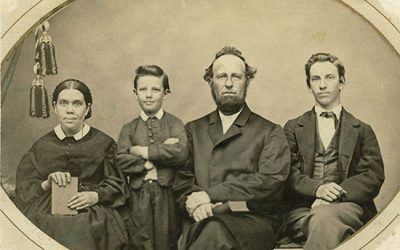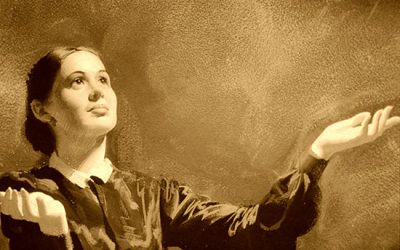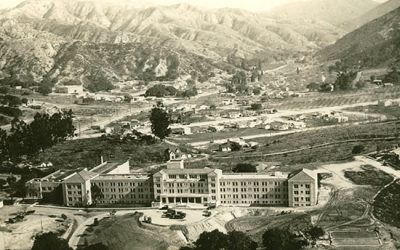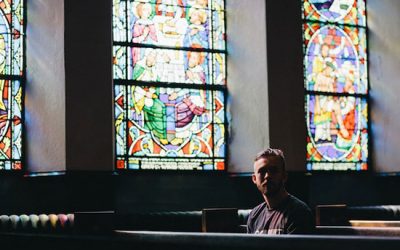The Millerite Movement
The Millerite Movement was a religious revival that followed the Second Great Awakening in North America. It started with William Miller, an earnest student of the Bible. Due to a misinterpretation of a prophecy in the book of Daniel, he and his followers concluded that Jesus Christ was coming back sometime around 1843 or 1844.
His goal was to prepare the world.
Though mostly documented in the United States, the movement had a worldwide impact.
When Jesus didn’t come back in 1844, the Millerite Movement dissolved, but it left its mark on American history. It sparked the beginning of the Seventh-day Adventist Church, which is a thriving Christian denomination today.
Let’s explore 4 questions about this movement:
- Who were the Millerites?
- What did the Millerites believe?
- What was Ellen G. White’s connection to the Millerite Movement?
- How did the Millerite Movement impact the Seventh-day Adventist Church?
Who Were the Millerites?

Photo by Priscilla Du Preez on Unsplash
The people in this movement were ordinary American people, many already church-going Christians. They took their name from William Miller—a farmer-turned-preacher who discovered exciting things after studying prophecy in the Bible.
While serving in the War of 1812, Miller came face to face with the fragility of life. Upon returning home, he gave his life to God and began to study the Bible from cover to cover.1
The Bible’s prophecies caught his attention.
He wondered:
If prophecies of the past had been fulfilled in a literal way, then what about the prophecies of the future?
And specifically, what about the second coming of Jesus Christ? Miller concluded that it must also be a literal event that would happen soon.2
And what he discovered would spur the Millerite Movement.
Daniel 8:14

Photo by Sincerely Media on Unsplash
The book of Daniel, with its visions and symbols, drew William Miller in.
Especially Daniel 8:14:
“For two thousand three hundred days; then the sanctuary shall be cleansed” (NKJV).
According to the popular teachings of his time, Miller thought the sanctuary symbolized the earth. The cleansing, then, must be the fire that would cleanse the earth at Jesus Christ’s second coming.
But when would it happen?
If Miller could figure out the starting date for the prophecy, then he would know the time of Christ’s return.
Based on passages like Ezekiel 4:5–6 and Numbers 14:34, he observed that one prophetic day equals a literal year. Reformers, such as Martin Luther and John Newton, had believed in this “day-for-year” principle too.
Thus, the 2300 prophetic days represented 2300 literal years.
By studying Daniel 9:24–27, Miller found a starting date for the prophecy: 457 BC.
Here are some points from his study:
- The same angel that gave Daniel the 2300-year prophecy (Daniel 8:14) returned to explain it to him (Daniel 9:22, 23).
- The explanation included another prophecy of 490 years (Daniel 9:24–27), which had to be part of the 2300-year prophecy.
- The 490 years was supposed to begin at the time of the decree to rebuild Jerusalem.
- According to historical records, the most complete decree was issued by Artaxerxes in 457 BC (Ezra 7).
- This date, then, was the beginning of both the 490-year and 2300-year prophecies.
And if they started in 457 BC, the 2300 years would end in 1843.
That meant Jesus was coming in less than 25 years!
What was Miller to do?
Tell the world
Miller had come to his conclusions by 1818. But he wasn’t ready to share them with the world.
If he were wrong, he didn’t want to mislead anyone.
For five years, he continued to study and wrestle with the conviction to share his findings.3
In 1831, an opportunity came when Miller received an unexpected invitation to speak.
It wasn’t long before more invitations were flooding in. Miller received so many that he had to reject over half of them!4
The explosion of the movement
In 1840, William Miller met Joshua V. Himes, a fiery leader in the social reform movement. Himes became convinced of Miller’s message and negotiated for Miller to speak at a chapel in Boston.
It was his first speaking engagement in a large city. The turnout was so overwhelming, there wasn’t enough room for everyone!5
From then on, Himes joined forces with Miller as his promoter. He scheduled speaking opportunities and published a magazine to spread Miller’s teachings.6
At this point, the movement took off, and others began preaching the message of Jesus’ soon coming. It was particularly widespread among believers in the Christian church in New England.
The interest in Bible prophecy was growing.
Tent meetings began popping up all over. To provide the movement with some structure, Himes organized “general conferences.” These meetings allowed leaders to study the Bible and make plans for larger gatherings.
A revival, much like the Great Awakenings of the late 18th and early 19th centuries, swept throughout the country. Thousands gave their lives to God.7
A Methodist yearbook estimates that 256,000 conversions took place between 1840 and 1844!8
And the movement wasn’t limited to North America.
It was worldwide. The message of Christ’s soon coming spread throughout Germany, Holland, other parts of Europe, and even India and Asia.9
The “tarrying” time

Photo by Aron Visuals on Unsplash
Miller preached that Jesus Christ would come sometime between March 21, 1843, and March 21, 1844.10
But 1843 came and went. Then the spring of 1844 passed.
What now?
Discouragement settled over the people, though many still believed Jesus would come.
They called this period the “tarrying time,” which meant a time of waiting or delay.
The phrase came from Habakkuk 2, in which the prophet Habakkuk cried to God for justice. He received the assurance that the coming of God and His kingdom would be the answer to that cry. But it would be delayed.
The Millerites applied Habakkuk 2:3 to the delay in Jesus’ coming that they were experiencing:
“The vision is yet for an appointed time;
But at the end it will speak, and it will not lie.
Though it tarries, wait for it;
Because it will surely come,
It will not tarry” (NKJV).
But what happened next sparked the movement back to life.
The Midnight Cry

Photo by Artiom Vallat on Unsplash
At a New England tent revival meeting in August 1844, a Millerite named Samuel Snow came riding in with a message.
When given the floor to speak, he explained that the calculation of the prophecy had been off. Jesus would not come until October 22, 1844.
Here’s why:
First, they realized that the decree to rebuild Jerusalem in 457 BC didn’t reach Jerusalem until the fifth month of the year (Ezra 7:8). Since the Jewish year began in the spring, that would have positioned the 2,300-year prophecy to end sometime in the fall.
Second, the cleansing of the sanctuary mentioned in Daniel 8:14 was closely connected to the Jewish feast called the Day of Atonement. This event always fell on the tenth day of the seventh month of the Karaite Jewish calendar. In 1844, it was supposed to occur on October 22nd.11
That was only a couple of months away!
Snow’s message, known as the “Midnight Cry,”12 aroused the Millerites like never before.
One Millerite wrote:
“It swept over the land with the velocity of a tornado, and it reached hearts in different and distant places almost simultaneously.”13
As people proclaimed the soon coming of Jesus, they lived out their faith too. Storeowners closed their shops to spread the message. Farmers chose not to harvest their crops.14
But the Millerites were to be disappointed again.
October 22, 1844 came and went.
Jesus didn’t come.
After this date, the Millerite Movement petered out.
What Did the Millerites Believe?
The Millerites were an eclectic group from many different denominations—Baptist, Methodist, Congregationalist, Episcopalian, and Lutheran, to name a few.
But they had some things in common.
To begin, their understanding of prophecy was unique. At that time, a mainstream viewpoint in the Christian church was postmillennialism.15 This was the idea that the condition of the world would continue to improve in preparation for a thousand years of peace. When this new age began, Christ would come “spiritually” and reign in people’s hearts. But He wouldn’t come to earth in a literal sense until the end of the thousand years.
The Millerites did not agree.
They believed that the second coming of Jesus would take place before the thousand years of Revelation 20.
Furthermore, the prophecies of the Bible would take place in a literal, physical manner—just as Jesus first came to the earth.16
Jesus’ soon coming
With this framework, the Millerites looked forward to Jesus’ literal arrival.
They studied passages from both the Old and New Testament that talked about the signs and manner of that event:
- Matthew 24; Matthew 25:1–13
- Joel 2:28–30
- 1 Corinthians 15:51–53
- 1 Thessalonians 4:16–17
The first and second angels’ messages of Revelation 14
Revelation 14:6–8 was another Bible passage that shaped the views of the Millerites.
In it, angels fly from heaven with the “everlasting gospel to preach to those who dwell on the earth” (Revelation 14:6, NKJV).
The first angel calls the world to “fear God and give glory to Him, for the hour of His judgment has come” (Revelation 14:7, NKJV). The Millerites honed in on this latter part of the verse: They urged people to prepare because Jesus Christ was coming to judge the earth.
The second angel declared: “Babylon is fallen, is fallen” (Revelation 14:8, NKJV). The Millerites understood “Babylon” as a reference to the confusion of false teaching. It applied to churches that had refused to accept God’s truth.
As the Christian church at large rejected Jesus’ soon coming,17 the Millerites chose to leave their denominations in obedience to this second angel’s message.
What Was Ellen G. White’s Connection to the Millerite Movement?
The Millerite Movement had a personal impact on Ellen G. White, who would later become a founder of the Seventh-day Adventist Church.
She was 12 years old when she first heard William Miller preach in her hometown in New England. Ellen and her family, the Harmons, joined the Millerite Movement.
Up to this point, they had attended the Methodist church, where her father had been a leader.18
However, when the Harmon family refused to give up their new beliefs, the church removed them from membership.19
Despite this opposition, Ellen had an inner joy. Jesus was coming soon!
She later wrote:
“This was the happiest year of my life.”20
When the first disappointment occurred in 1843, Ellen recorded:
“We were perplexed and disappointed, yet did not renounce our faith. Many still clung to the hope that Jesus would not long delay His coming; the word of the Lord was sure, it could not fail.”21
Even after October 22, 1844, she continued to cling to her faith.
She joined a group of believers who were trying to make sense of the Great Disappointment. They continued to study the Bible for truth.
Later, they would establish the Seventh-day Adventist Church.
How Did the Millerite Movement Impact Seventh-day Adventist History?

Photo by Chris Brignola on Unsplash
After the Great Disappointment, many disillusioned Millerites walked away for good.
Others tried to reconcile why Jesus Christ hadn’t returned.
The latter can be divided into three groups:22
- Those who believed the date was wrong, but that Christ’s coming would take place soon.
- Those who believed that Christ had come in a “spiritual” sense—into people’s hearts.
- Those who believed the date was correct, but the expected event was not.
The third group would become the Seventh-day Adventist Church.
In fact, many of Adventism’s key figures were first Miller’s followers. These individuals include James White, Ellen G. White, George Storrs, and Joseph Bates.
Among them was also a man named Hiram Edson.
After the clock had struck midnight on the morning of October 23, Edson, though disappointed, had spent time in prayer.
Spurred by a strong impression, he gathered other Millerites and began to restudy the meaning of the “sanctuary” of Daniel 8:14.
What did it really mean?
They soon learned that God had a sanctuary in heaven (Hebrews 8:1–2). Jesus had entered there to begin cleansing the records of sin with His blood (Hebrews 9:11–14).
Edson also studied Daniel 7:10–13, which depicts Jesus coming to God the Father for a time of judgment.23 The judgment was connected with the cleansing in heaven. It needed to take place before Jesus came back so that it could prepare the way for Him to receive His kingdom.
This was the key that helped explain the disappointment. Jesus was not supposed to return on October 22, 1844. Instead, He had moved from the Holy Place to the Most Holy Place of the sanctuary in heaven to begin an important phase of His work!
These discoveries laid the foundation for Seventh-day Adventist doctrine, along with a renewed hope in the loving, redemptive work of Jesus Christ toward humanity.
Beliefs from the Millerite Movement

Photo by Sebastien Gabriel on Unsplash
What other ways did the Millerite Movement prepare the way for Seventh-day Adventists?
For one, it emphasized a historical interpretation of Bible prophecy. Adventists continued to use this framework as they studied Daniel and Revelation.
Like the Millerites, Adventists did not accept the doctrine of postmillennialism. They believed that Christ’s second coming would occur before the thousand years (Revelation 19, 20).
The Second Coming also became an important part of Seventh-day Adventists’ teaching and name! Adventist refers to the way that they await the second advent, or coming, of Jesus.
Another key belief is the first and second angels’ messages of Revelation 14.
Adventists believe that the announcement of the judgment (Revelation 14:7) is even more significant today.
Why?
Because Jesus is conducting a work of judgment in the heavenly sanctuary right now.
New Beliefs

Photo by Gift Habeshaw on Unsplash
Seventh-day Adventists did not accept all the beliefs of the Millerite Movement.
As they studied the Bible, they uncovered new truths.
So what were some of those differences in doctrine?
For one, Seventh-day Adventists restudied the “cleansing of the sanctuary.” They realized that it wasn’t about the cleansing of the earth by fire. Instead, it referred to Jesus’ final work in the heavenly sanctuary.
Adventists called this doctrine the investigative judgment.
Another major difference was their understanding of the “shut door.”
Millerites, with their belief in Jesus Christ’s coming in 1844, believed that the opportunity for salvation would end not long before.24 In other words, “the door of mercy would close against all rejecters of the first angel’s message.”25
Adventists, however, soon turned away from this idea.
They recognized verses such as 2 Peter 3:9, which reminds us that God is “not willing that any should perish but that all should come to repentance” (NKJV).
As long as Jesus is still doing His work of judgment, the door of salvation is open. His love embraces all of humanity and gives them as many opportunities as possible for coming to Him!
The Influence of the Millerite Movement Lives On
Because the Millerites misunderstood October 22, 1844, they faced bitter disappointment.
But through the disappointment, God was still working.
The Millerite movement planted important seeds about biblical prophecy and the Second Coming that would inspire fervent Bible study. The results of this deep dive into Scripture led to the Advent Movement, and later the Seventh-day Adventist Church.
And this hope of the Second Coming still inspires Adventists today.
To learn more about the growth of the Seventh-day Adventist Church and its beliefs, start with our article “Who are Seventh-day Adventists?”
[1] Bliss, Sylvester, and Hale, Apollos, Memoirs of William Miller, (J.V. Himes, 1853), p. 68–69.
[2] Ibid., p. 72.
[3] Ibid., p. 81, 92.
[4] Ibid., p. 99.
[5] Maxwell, C. Mervyn, Tell It to the World, (Pacific Press, Nampa, ID, 1977), p. 16.
[6] Bliss and Hale, p. 104.
[7 Maxwell, p. 18–20.
[8] Bliss and Hale, p. 117
[9] Loughborough, J. N., The Great Second Advent Movement, (Adventist Pioneer Library, Jasper, Oregon, 2016), p. 85–91.
[10] Maxwell, p. 26.
[11] Maxwell, p. 30–31.
[12] Based on Jesus’ Parable of the Ten Virgins (Matthew 25)
[13] Southard, N., Midnight Cry, Oct. 31, 1844.
[14] Bliss and Hale, p. 141.
[15] Pointer, Steven R., “American Postmillennialism: Seeing the Glory,” Christianity Today, No. 61, 1999. https://www.christianitytoday.com/history/issues/issue-61/american-postmillennialism-seeing-glory.html
[16] Bliss, Hale, and Himes, “Vindication,” Advent Herald, Nov. 13, 1844.
[17] Maxwell, p. 27.
[18] White, Ellen, Testimonies for the Church, vol. 1, (Pacific Press, Mountain View, California, 1855), p. 42.
[19] Ibid., p. 21.
[20] Ibid., p. 54.
[21] White, Ellen, Life Sketches of Ellen G. White, (Pacific Press, Mountain View, California, 1915), p. 57.
[22] Douglass, Herbert, Messenger of the Lord, (Pacific Press, Nampa, Idaho, 1998), p. 134.
[23] Maxwell, p. 52.
[24] Douglass, p. 554–555.
[25] Maxwell, p. 153.
More Answers
How Can I Know Ellen White’s Messages Were From God?
It’s natural to be a bit skeptical when you hear about someone being “divinely inspired,” or that something is a “message from God,” etc. And we expect nothing different if you’re hearing about Ellen White, an influential co-founder of the Seventh-day Adventist Church, for the first time. After all, the Bible tells us that we’re supposed to test these things!
Ellen G. White’s Time in Australia
Ellen White traveled to Australia in the later part of her life, and she ended up spending nine years there. In that time, she helped the Australian Seventh-day Adventist Church increase in size and strength.
Ellen G. White’s Time in Europe
When the Seventh-day Adventist Church was still young, a council of the church in Europe requested Ellen White, one of Adventism’s key leaders, to come to Europe. Despite the many obstacles, God led her there to help the new churches and members for two years.
Ellen G. White’s Travels and Worldwide Mission
Though Ellen White, a co-founder of the Seventh-day Adventist Church, is best known for her ministry in the United States, she also traveled to twelve other countries in her lifetime—a big accomplishment in the 19th century when travel was strenuous and long.
Ellen G. White’s Counsel on College Education
Ellen G. (Harmon) White, a significant co-founder of Adventism, is often known for her practical and spiritual guidance for proper childhood education. But she was also significantly involved in the development of Seventh-day Adventist higher education.
8 Pieces of Advice from Ellen White’s Counsel for Families
In this article, we’ll look at the insight Ellen White received from God. We’ll cover 8 major themes she highlighted for families.
Was Everything Ellen White Said Divinely Inspired?
The Seventh-day Adventist Church believes that many of Ellen White’s messages were inspired by God. But that doesn’t mean everything she ever said was prophetic, or meant to be taken as direct instruction from God. So let’s break down how to identify the nature of her many written messages and quotes.
Who Were Ellen White’s Children?
Being the children of a woman with a prophetic calling from God had its blessings and its challenges.
In this overview, we’ll look at the highlights of the lives of Ellen White’s sons during her many years of ministry, as well as the ways each of them decided to serve Jesus Christ:
Ellen White’s Spiritual Counsel on Marriage
Ellen White’s Spiritual Counsel on MarriageAs one of the founders of the Seventh-day Adventist Church, Ellen G. White was held in high regard. She was a prolific author and was heavily engaged in the mission of the denomination, prayerfully pursuing the guidance of...
Ellen G. White or the Bible—Which is More Important to Adventists?
Ellen G. White or the Bible—Which is More Important to Adventists?The Bible—without a shadow of a doubt—is the most important book. It’s the standard we use to test all other writings, including those of Ellen White. The Seventh-day Adventist Church believes that “the...
Are Any of Ellen G. White’s Prophecies Yet to Come True?
Ellen White, a co-founder of the Seventh-day Adventist Church, demonstrated many times over that she had the spiritual gift of prophecy. Some of her predictions’ timelines have already passed, and those prophecies have been fulfilled. Others have yet to be fulfilled.
What Was Ellen G. White’s Counsel on Music?
Ellen G. White, one of the founders of the Seventh-day Adventist Church, also provided helpful guidance regarding music choices for Christians. She provided sound principles to answer questions the young Adventist Church had.
What Ellen White Said About Using the Bible in Education
Ellen White, one of the founders of the Seventh-day Adventist Church, believed that education was not complete unless it was founded upon the principles of the Bible.
But what does the Bible have to do with math or science? Is it important to integrate the Bible with schoolwork?
What Were Ellen White’s Visions About the Adventist Church?
What Were Ellen White’s Visions About the Adventist Church?Led by the Holy Spirit, Ellen G. White was given many messages, counsel, revelations, and visions about the Bible, history, prophecy, and how we can apply biblical principles to our daily lives. She was also a...
Was Ellen G. White Really a Prophet?
If you look at what Scripture provides as tests for a true prophet, Ellen White meets all the criteria.
What is the Spirit of Prophecy (Books 1–4) by Ellen G. White?
Applying biblical prophecy to history, recent events, and especially the future, can be a daunting task. Even a little scary for some. But even so, we can’t help but want to know more. We want to be prepared—to feel like we know how to weather the storm.
Ellen G. White’s Counsel on Christian Education
Ellen White, a co-founder of the Seventh-day Adventist Church, saw that the U.S. educational system during her time was lacking. And as part of her life of ministry, she sought out practical ways to be better stewards of our minds, bodies, and the lives we’re given.
What Does Ellen White Say About Prayer?
Have you ever had a burden you just had to tell someone, but you were afraid of being judged if you did? Ellen G. White, an important figure in the Seventh-day Adventist Church and a prolific writer, described prayer as talking to God in a personal way—He’s the friend we can tell everything to.
Were All Ellen White’s Visions About the Future?
While the visions God gave Ellen White were often about the distant future or last-day events, she had many others that addressed different topics. They may not be discussed as much as her visions about the Second Coming or the End Times, but they tackled some timely topics for her day.
What Did Ellen White Say About End-Time Prophecy?
We can read in Scripture about the series of events and signs that lead up to the second coming of Jesus Christ. And it sounds pretty intense, to say the least. The symbolic nature of the language of prophecy also can make things tricky to understand at first.
Were All Ellen White’s Books Inspired?
As the most translated female author in the world, Ellen White wrote numerous books, articles, pamphlets, and more. These writings focused on developing Christian character, emphasizing Bible truth, practical tips for living well and staying healthy, and discussing effective methods of delivering the gospel message to the world.
How Ellen White Influenced the Adventist Health Message
Seventh-day Adventists are known for their emphasis on healthy living. And Ellen G. White was a significant influence in the development of this priority and practice among Adventists.
What Did Ellen White Teach About Vegetarianism?
One thing you might have heard about Seventh-day Adventists is their emphasis on a vegetarian lifestyle. If you’re wondering why that is, it goes back to our church’s humble beginnings:
Steps to Christ: A Guide to a Relationship with Jesus
Whether you’re just starting your journey with Jesus Christ, are coming back after some time away, or have had a relationship with Jesus for years, using a book—in addition to the Bible—to guide or supplement that relationship can be helpful, comforting, and joyful.
Ellen White and Adventist Healthcare—Ahead of Their Time
Medical care in the mid-1800s was primitive, to say the least. Basic concepts we take for granted—such as proper handwashing or recognizing the dangers of bloodletting—were nonexistent. And doctors often had little more than nine months of training!
How Ellen White’s Teachings Can Improve Your Health
Healthcare in the nineteenth century was said to leave “more disease than it took away” with its use of bloodletting and “medicines” like mercury and arsenic. As people questioned these methods, new approaches popped up. But which ones were reliable?
Do Adventists Worship Ellen White?
Ellen White was a co-founder and leader in the Seventh-day Adventist Church from its beginning. Adventists believe that she had the prophetic gift (Ephesians 4:14; 1 Corinthians 12:28) and passes the biblical tests of a prophet.
Can I Be an Adventist If I Don’t Believe in Ellen White?
Ellen White is an important part of the Seventh-day Adventist Church: she played a significant role in its founding, provided biblical support for several key doctrines, and continues to inspire church members today with her insightful counsel.
Who was J.N. Andrews and How Did He Contribute to Adventism?
John Nevins Andrews (1829–1883) was an influential leader in the early days of the Seventh-day Adventist Church. He was a Bible scholar who helped shape several Adventist beliefs and juggled many roles in the Church. Most notably, he was the first official missionary for the Adventist Church outside North America.






























